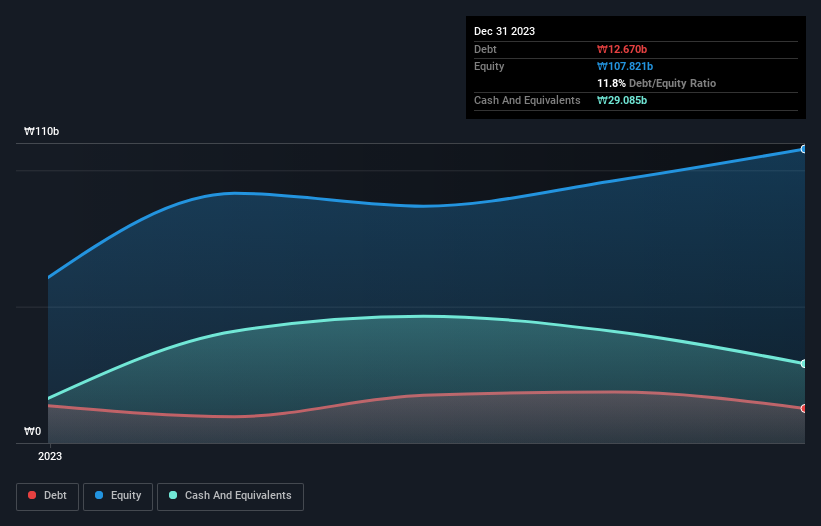- South Korea
- /
- Construction
- /
- KOSDAQ:A282720
Kumyang Green Power (KOSDAQ:282720) Has A Somewhat Strained Balance Sheet
The external fund manager backed by Berkshire Hathaway's Charlie Munger, Li Lu, makes no bones about it when he says 'The biggest investment risk is not the volatility of prices, but whether you will suffer a permanent loss of capital.' So it might be obvious that you need to consider debt, when you think about how risky any given stock is, because too much debt can sink a company. As with many other companies Kumyang Green Power Co., Ltd. (KOSDAQ:282720) makes use of debt. But should shareholders be worried about its use of debt?
When Is Debt Dangerous?
Generally speaking, debt only becomes a real problem when a company can't easily pay it off, either by raising capital or with its own cash flow. Ultimately, if the company can't fulfill its legal obligations to repay debt, shareholders could walk away with nothing. However, a more common (but still painful) scenario is that it has to raise new equity capital at a low price, thus permanently diluting shareholders. By replacing dilution, though, debt can be an extremely good tool for businesses that need capital to invest in growth at high rates of return. When we think about a company's use of debt, we first look at cash and debt together.
Check out our latest analysis for Kumyang Green Power
What Is Kumyang Green Power's Net Debt?
The image below, which you can click on for greater detail, shows that Kumyang Green Power had debt of ₩12.7b at the end of December 2023, a reduction from ₩13.7b over a year. But it also has ₩29.1b in cash to offset that, meaning it has ₩16.4b net cash.

How Healthy Is Kumyang Green Power's Balance Sheet?
The latest balance sheet data shows that Kumyang Green Power had liabilities of ₩70.2b due within a year, and liabilities of ₩6.78b falling due after that. Offsetting this, it had ₩29.1b in cash and ₩45.1b in receivables that were due within 12 months. So it has liabilities totalling ₩2.80b more than its cash and near-term receivables, combined.
This state of affairs indicates that Kumyang Green Power's balance sheet looks quite solid, as its total liabilities are just about equal to its liquid assets. So while it's hard to imagine that the ₩188.4b company is struggling for cash, we still think it's worth monitoring its balance sheet. While it does have liabilities worth noting, Kumyang Green Power also has more cash than debt, so we're pretty confident it can manage its debt safely.
In fact Kumyang Green Power's saving grace is its low debt levels, because its EBIT has tanked 33% in the last twelve months. Falling earnings (if the trend continues) could eventually make even modest debt quite risky. When analysing debt levels, the balance sheet is the obvious place to start. But you can't view debt in total isolation; since Kumyang Green Power will need earnings to service that debt. So when considering debt, it's definitely worth looking at the earnings trend. Click here for an interactive snapshot.
Finally, while the tax-man may adore accounting profits, lenders only accept cold hard cash. Kumyang Green Power may have net cash on the balance sheet, but it is still interesting to look at how well the business converts its earnings before interest and tax (EBIT) to free cash flow, because that will influence both its need for, and its capacity to manage debt. In the last two years, Kumyang Green Power created free cash flow amounting to 4.5% of its EBIT, an uninspiring performance. For us, cash conversion that low sparks a little paranoia about is ability to extinguish debt.
Summing Up
We could understand if investors are concerned about Kumyang Green Power's liabilities, but we can be reassured by the fact it has has net cash of ₩16.4b. So while Kumyang Green Power does not have a great balance sheet, it's certainly not too bad. The balance sheet is clearly the area to focus on when you are analysing debt. However, not all investment risk resides within the balance sheet - far from it. For instance, we've identified 4 warning signs for Kumyang Green Power (1 shouldn't be ignored) you should be aware of.
If, after all that, you're more interested in a fast growing company with a rock-solid balance sheet, then check out our list of net cash growth stocks without delay.
Valuation is complex, but we're here to simplify it.
Discover if Kumyang Green Power might be undervalued or overvalued with our detailed analysis, featuring fair value estimates, potential risks, dividends, insider trades, and its financial condition.
Access Free AnalysisHave feedback on this article? Concerned about the content? Get in touch with us directly. Alternatively, email editorial-team (at) simplywallst.com.
This article by Simply Wall St is general in nature. We provide commentary based on historical data and analyst forecasts only using an unbiased methodology and our articles are not intended to be financial advice. It does not constitute a recommendation to buy or sell any stock, and does not take account of your objectives, or your financial situation. We aim to bring you long-term focused analysis driven by fundamental data. Note that our analysis may not factor in the latest price-sensitive company announcements or qualitative material. Simply Wall St has no position in any stocks mentioned.
About KOSDAQ:A282720
Kumyang Green Power
Engages in the general construction business in South Korea.
Adequate balance sheet with moderate growth potential.
Market Insights
Community Narratives


Recently Updated Narratives

Constellation Energy Dividends and Growth

CoreWeave's Revenue Expected to Rocket 77.88% in 5-Year Forecast

Bisalloy Steel Group will shine with a projected profit margin increase of 12.8%
Popular Narratives


MicroVision will explode future revenue by 380.37% with a vision towards success


NVDA: Expanding AI Demand Will Drive Major Data Center Investments Through 2026



